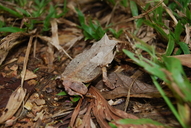|
Description
This species has an elongated triangle “horn" present on each upper eyelid, and a pointed snout. The pupils are vertical with a dark brown iris. There is a fold of skin separating the head from the body. Dorsally, the skin is generally light brown or gray, with one or two pairs of dorsal ridges extending from behind the head down to the groin. The dorsal part is usually covered by patches of some small tubercles. The body shape and color resemble the appearance of a forest ground floor. A dark triangular blotch occurs behind the eyes. Distribution and Habitat
Country distribution from AmphibiaWeb's database: Philippines
This frog is endemic to Balabac and Palawan Islands, in the western Philippines. It occurs in lowland and montane rainforests, in forest floor leaf litter, near streams. Life History, Abundance, Activity, and Special Behaviors
This frog lives in leaf litter and remains immobile unless touched or molested. It is active day and night (P. Fidenci, personal observation 2006). Frogs in the genus Megophrys rely on camouflage for defense; they move by short hops, since the combination of large, wide heads and bodies and short, slender legs hampers long jumps. The tadpoles are suspension feeders, found in quiet pools in streams (Stuart et al. 2008). Trends and Threats
Probably decreasing but surveys and monitoring are needed, along with conservation of riparian habitat and gallery forests. Habitat loss is the major threat as lowland rainforest is lost to agriculture. Megophrys ligayae is present in several protected areas, but pollution of montane streams and rivers due to agricultural runoff and mining is negatively impacting this species (Stuart et al. 2008).
Possible reasons for amphibian decline General habitat alteration and loss
Habitat modification from deforestation, or logging related activities
Intensified agriculture or grazing
Mining
Drainage of habitat
Habitat fragmentation
References
Fidenci, P. (2006). Personal observations on Megophrys ligayae. 10°52’06.18’’ N and 119° 29’19.43’’ E. Municipality of Tatay, Palawan, Philippines. March 2006.
Stuart, S., Hoffmann, M., Chanson, J., Cox, N., Berridge, R., Ramani, P., Young, B. (eds) (2008). Threatened Amphibians of the World. Lynx Edicions, IUCN, and Conservation International, Barcelona, Spain; Gland, Switzerland; and Arlington, Virginia, USA.
Originally submitted by: Pierre Fidenci (first posted 2009-07-23)
Edited by: Kellie Whittaker (2009-08-20)Species Account Citation: AmphibiaWeb 2009 Pelobatrachus ligayae: Palawan Horned Frog <https://amphibiaweb.org/species/6177> University of California, Berkeley, CA, USA. Accessed Feb 3, 2025.
Feedback or comments about this page.
Citation: AmphibiaWeb. 2025. <https://amphibiaweb.org> University of California, Berkeley, CA, USA. Accessed 3 Feb 2025.
AmphibiaWeb's policy on data use.
|




 Map of Life
Map of Life